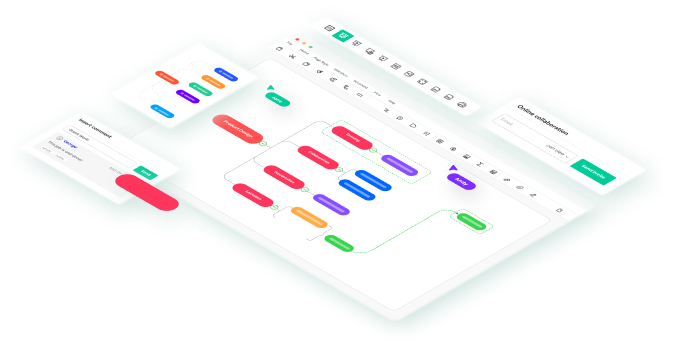Teams look for techniques that improve efficiency and adaptability. Kanban, a visual workflow management system, has become an indispensable tool. Kanban, derived from Toyota's manufacturing methods, stresses continual delivery without overburdening team members.
Visualizing activities and limiting work in progress helps teams detect bottlenecks, improve operations, and adapt quickly to changing demands.
This article goes into Kanban principles and how they apply to project development. Let's take a look at EdrawMind, a user-friendly mind mapping and work management tool with Kanban capability.
In this article
What is Kanban?
Kanban, derived from the Japanese word for "signboard" or "billboard," is a visual workflow management system that aims to maximize efficiency and promote continuous improvement.
Kanban, a concept created by Toyota in the late forties, was previously an effective instrument for the economy since it matched goods and services offered with effective demand, and as a result, surplus and wastage were minimized.
Elements of a Kanban
The key elements of Kanban include
- visualizing work and processes,
- limiting work in progress (WIP),
- and managing flow.
On a kanban board, divided into columns to represent the workflow stages, such as ‘To Do,’ ‘In Progress,’ and ‘Done,’ work items are represented as cards.
That way, the team members can easily keep track of the current position of the job and find where some processes are stuck so that they can proceed towards those critical points and boost their performance.
At the heart of Kanban is WIP limits, a set ceiling on the number of ‘work in progress’ tasks that may occur in a specific workflow stage. The goal of teams is to maintain a moderate weight of in-progress tasks to ensure that all activities are completed before new ones are started, thus encouraging productivity.
When Will You Use a Kanban
Although Kanban is associated with manufacturing, it has also been employed in numerous disciplines, such as software development, project management, and healthcare. Its flexibility and emphasis on continuous delivery make it ideal for workplaces where work arrives unexpectedly and demands quick adaption.
In a nutshell, Kanban is a visual and agile system of managing workflow that recognizes and promotes transparency, limits the amount of work in progress, and stimulates perpetual evolution and growth within a team. It is, therefore, very effective for organizations that seek to be most efficient while continuously improving their responsiveness levels.
How to Use Kanban in Project Development?
Kanban in project development enables teams to see tasks, manage processes more effectively, and increase productivity.
Here's a step-by-step guide on using Kanban in project development, including the basic methods for establishing and refining a Kanban system for efficient project management.
1. Set up Your Kanban Board
A Kanban board is an efficient tool displaying activities and steps in project progressions. You should begin by designing a board that can be divided into several workflow elements. Layouts such as ‘Backlog,’ ‘To Do,’ ‘In Progress,’ ‘Review,’ and ‘Done’ are the most commonly used. These can be tailored to suit the requirements of particular projects.
Every task is assigned a card that details various aspects, such as its description, its owner, its ranking, and the date it is due. This way, each member of the team can know where each task stands and its significance to the project.
2. Define Work-in-Progress (WIP) Limits
The use of work-in-progress (WIP) limits places a cap on the number of tasks that can appear under certain types of columns and thus reduces the likelihood of overloading effort while creating a more balanced workflow.
Moving tasks to the active or review columns helps the team empty the work in progress and control multitasking, which enhances the team's overall productivity.
Setting WIP limits is a collaborative effort that considers realism, the team's operational potential, and the project's expectations. These limits should be monitored and updated frequently to achieve the desired optimum outcome.
3. Reinforce Time and Priority with Colouring the Tasks
Use colors, labels, and tags to highlight tasks that are very important or time-sensitive. Most applications that use the Kanban system in computer environments use color codes, which enable easy distinction of the various tasks' urgency levels.
Turning on deadlines, dependencies, or issue/ blockage flags onto advanced/secondary cards enables the team to work on the most urgent tasks and solve problems much faster, thus reducing project completion time.
4. Develop a Routine for Reviewing the Board
In team meetings, active discussion of the progress made on the tasks is enriched by updating the Kanban board, visualizing where there are likely to be obstacles, and what steps will be needed to implement changes. Most teams will have daily stand-ups or weekly check-ins to update everyone on their tasks and related issues.
Retrospectives, at least one at the end of every (formal) stage of a project or regularly, allow the unit to self-appraise performance parameters and identify areas for improvement in the Kanban operation in the next series of projects.
5. Emphasis Should Be on the Process, Not Finished Products
Every classical Kanban project management methodology has a due date for the project, but in Kanban, we embrace a continuous workflow. To maintain a steady state of work, there is no conspicuous deadline for projects sitting in the pipeline, making it possible to be highly responsive to evolving requirements.
This is not to say that deadlines do not apply, especially when a deliverable is directed to a customer. In Kanban, however, there are no target times for completing a task; rather, there is a focus on moving the task across the workflow, which makes the approach useful for projects characterized by dynamic needs.
6. Analyze and Improve Workflow
Kanban emphasizes continuous improvement. Tracking key metrics such as lead time (the time from task creation to completion) and cycle time (the time from start to finish) will help you understand your processes' efficiency. If bottlenecks are found, team members can collaborate to devise remedies, such as reducing WIP limits or reassigning jobs.
When analyzing performance data, the team can recognize patterns and areas for enhancement, which leads to improved efficiency and enhancement of the process in the long run.
How to Create a Kanban Board
Many tools offer Kanban capabilities, and choosing a simple and easy-to-use tool can greatly improve productivity. It can save you time and effort, and simple features can make the creation process smoother, allowing you to focus more on managing taste rather than learning complex software.
One such tool is EdrawMind by Wondershare. It has an intuitive interface and flexible features that make task management easier. One standout feature is its Kanban function, which allows you to manage tasks visually.
Step 1
Download EdrawMind or Try it Online Free. Sign up or log in using Wondershare or social media account credentials.
Step 2
Select Task Kanban from the Home page.
Step 3
This opens the Kanban Board default canvas, where you can customize it. You can add more columns and cards to add details according to your project.

Step 3
Once you’re done adding more columns and all the details to the cards, you can use the right-panel options to change the color, design, and display of the elements.

Step 4
For further design customization in the particular card, right-click on it and select from the options.

Step 5
After all the changes, you can share this board with your team members or colleagues for feedback and collaboration.







